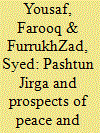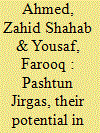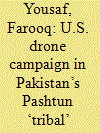|
|
|
Sort Order |
|
|
|
Items / Page
|
|
|
|
|
|
|
| Srl | Item |
| 1 |
ID:
171938


|
|
|
|
|
| Summary/Abstract |
There is growing recognition and appreciation of traditional approaches towards peace and conflict resolution across the world. This article aims to highlight the crucial role and consequential importance of traditional mechanisms of peace and conflict resolution in Pakistan’s terror-hit Pashtun ‘tribal’ areas, formerly known as the Federally Administered Tribal Areas (FATA). These ‘peripheral’ areas of Pashtun tribes stand in relative isolation from the ‘centre’ of the Pakistani ruling establishment. Moreover, with the onset of militancy since 2001 in the Afghanistan–Pakistan region, the situation has turned worse for the local Pashtun tribes. The article discusses the changing role of traditional mechanisms and local structures of peace and conflict resolution, arguing that colonial legacies have failed to prevent, manage, resolve or transform conflicts in post-colonial states such as Pakistan. Furthermore, the Pashtun cultural code of Pashtunwali, along with its various tenets and structures, especially Jirga (Pashtun tribal council) and Lashkar (tribal militia), is also discussed in the article. The article concludes that the changing socio-political situation, along with the rise of the secular Pashtun Tahafuz Movement (PTM), is presenting a challenge to ‘tribal’ Pashtun patriarchal values as well as traditional structures like Jirga in the region.
|
|
|
|
|
|
|
|
|
|
|
|
|
|
|
|
| 2 |
ID:
157486


|
|
|
|
|
| Summary/Abstract |
Relations between Pakistan and Afghanistan have mostly been hostile since 1947. The animosity has grown in complexity from various territorial disputes to frequent allegations of cross-border terrorism in the post-9/11 era. This article first makes a case for involving Jirgas, a traditional dispute resolution mechanism among Pashtuns, for improving peace dialogues between both countries. It presents evidence of the traditional acceptability of Jirgas by Pashtuns on both sides of the border and assesses previous official bilateral attempts of using Jirgas. It then proceeds to propose some new policy recommendations focused on national reconstruction of Afghanistan, which include involvement of the Taliban as an important local stakeholder. The dual key argument then becomes, first, that since Jirgas have long-standing local legitimacy and acceptability both in Afghanistan and Pakistan, using the strength of their social recognition would allow higher-level bilateral negotiations between the neighbours, enhancing the effectiveness of new and locally more credible forms of multi-track diplomacy. Second, reinvigorating the Jirga system would allow the Afghan people themselves to engage in fuller multi-dimensional debates on sustainable modalities for their own future, on terms to be set by them, not outsiders.
|
|
|
|
|
|
|
|
|
|
|
|
|
|
|
|
| 3 |
ID:
172570


|
|
|
|
|
| Summary/Abstract |
The U.S. drone campaign in Pakistan’s Pashtun ‘tribal’ areas, formerly known as FATA, has remained one of the most contentious issues since the war on terror began in 2001 in Afghanistan. Though drone strikes have polarised opinions, they have also resulted in the elimination of lower, middle and higher-level leaders of all militant groups based in the ‘tribal’ region. The U.S. drone campaign in the former-FATA region had some success in the elimination of terrorists. But lack of access to the ‘tribal’ areas coupled with the secrecy surrounding the drone campaign resulted in major discrepancies in the total number of U.S. drone strikes and the resultant casualties. These factors have contributed towards an anti-drone and anti-U.S. narrative in Pakistan, largely manufactured by Pakistani mainstream media. With the last drone strike taking place almost a year ago, this article argues that the U.S. drone campaign may have finally halted in Pakistan. However, even with a gradual halt, the ‘tribal’ areas can witness drone strikes in the future if high-profile terrorists, based on actionable intelligence, are located in the region.
|
|
|
|
|
|
|
|
|
|
|
|
|
|
|
|
|
|
|
|
|